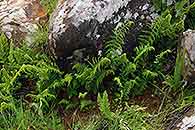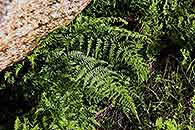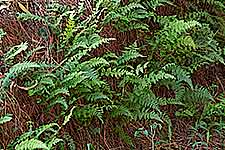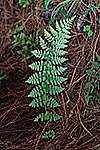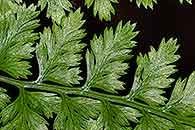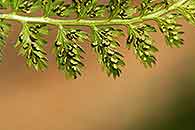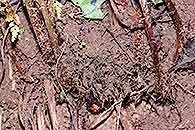Athyrium schimperi Moug. ex Fée
Synonyms |
Asplenium schimperi (Moug. ex Fée) A. Braun |
|---|---|
Common name |
|
Description |
Rhizome creeping and branching, 5-8 mm in diameter; rhizome scales lanceolate in outline, apex slowly tapering to a point, margin entire, up to 7 mm long, reddish-brown. Fronds monomorphic, closely spaced, erect, up to 1m tall, herbaceous. Stipe up to 38 cm long, sparsely set with long, pale brown, hair-like scales, more dense so towards the base, straw coloured to pale green, pink on new fronds. Lamina 3-pinnatifid to 3-pinnate, narrowly elliptic to ovate-lanceolate in outline, 23-70 cm × 8-28 cm, lower 4-5 pairs of pinnae reduced in size; pinnae 6-20 pairs, lanceolate in outline, widest at the base, apex tapering to a point, 4-18 x 1.5-5 cm, alternate, set at 80-90° to the rhachis; pinnules 7-18 pairs, unequaly ovate to narrowly oblong in outline, about twice as long as broad, with acroscopic lobe often enlarged, glabrous on both surfaces, margin deeply pinnatifid to sharply serrate-dentate lobes; rhachis pale brown, hairless but with few hairlike scales at the base of the pinnae. Sori 1-7 per pinnule lobe and 14-70 per pinnule, 0.8-1.5 mm, curved, elliptic to J-shaped; indusium pale brown, erose and membranous. |
Notes | Could be confused with A. newtonii, which is a forest species with an erect rhizome and basal pinnae that are not or slightly reduced. Also resembles A. crassicaule which has a branched rhizome with a series of short erect caudices and basal pinnae that are only slightly reduced. |
Derivation | schimperi: named after W.P. Schimper (1804-1878), German bryologist who first collected this species. |
Habitat | Rock overhangs, earth banks of shaded ravines, rock crevices, sometimes among boulders near streams, exposed or light shade in montane grassland. |
Distribution worldwide | Africa, India. |
Distribution in Africa |
Angola, Burundi, Cameroon, Dem. Republic of Congo, Ethiopia, Ghana, Kenya, Malawi, Nigeria, Rwanda, South Africa, Sudan and South Sudan, Tanzania , Uganda, Zambia, Zimbabwe. |
Growth form |
Terrestrial. |
Literature |
|

